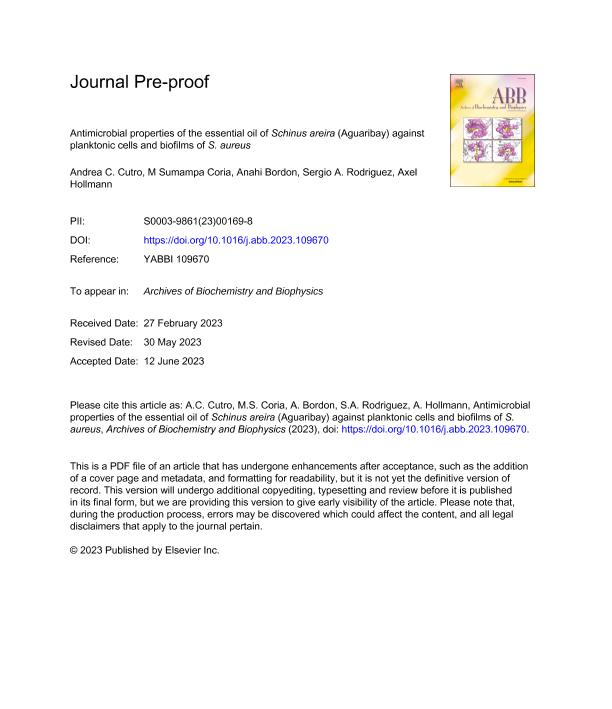Artículo
Antimicrobial properties of the essential oil of Schinus areira (Aguaribay) against planktonic cells and biofilms of S. aureus
Cutró, Andrea Carmen ; Coria, Maria Sumampa
; Coria, Maria Sumampa ; Bordón, Anahí
; Bordón, Anahí ; Rodríguez, Sergio Antonio
; Rodríguez, Sergio Antonio ; Hollmann, Axel
; Hollmann, Axel
 ; Coria, Maria Sumampa
; Coria, Maria Sumampa ; Bordón, Anahí
; Bordón, Anahí ; Rodríguez, Sergio Antonio
; Rodríguez, Sergio Antonio ; Hollmann, Axel
; Hollmann, Axel
Fecha de publicación:
08/2023
Editorial:
Elsevier Science Inc.
Revista:
Archives of Biochemistry and Biophysics
ISSN:
0003-9861
Idioma:
Inglés
Tipo de recurso:
Artículo publicado
Clasificación temática:
Resumen
The essential oil (EO) of Schinus areira L. (Anacardiaceae) leaves has shown antibacterial activity against Staphylococcus aureus. In this study, we aimed to unravel the mechanisms of its antibacterial action by using bacterial cells and model membranes. First, the integrity of the S. aureus membrane was evaluated by fluorescence microscopy. It was observed that there was an increase in the permeability of cells that was dependent on the EO concentration as well as the incubation time. For a deep comprension of the action of the EO on the lipids, its effect on the membrane fluidity was evaluated on DMPC (1,2-dimyristoyl-sn-glycero-3-phosphocholine): DMPG (1,2-dimyristoyl-sn-glycero-3-phospho-1′-rac-glycerol) (5:1) liposomes by dynamic light scattering and by using Laurdan doped liposomes. The results indicate that EO produces changes in lipid membrane packing, increasing the fluidity, reducing the cooperative cohesive interaction between phospholipids and increasing access of water or the insertion of some components of the EO to the interior of the membrane. In addition, the potential effect of EO on intracellular targets, such as the increase of cytosolic reactive oxygen species (ROS) and DNA damage, were analyzed. The EO was capable of increasing the production of ROS as well as inducing a partial DNA degradation. Finally, the effect of EO on S. aureus biofilm was tested. These assays showed that EO was able to inhibit the biofilm formation, and also eradicate preformed biofilms. The results show, that the EO seems to have several bacterial targets involved in its antibacterial activity, from the bacterial membrane to DNA. Furthermore, the antibacterial action affects not only planktonic cells but also biofilms; reinforcing the potential application of this EO.
Palabras clave:
BACTERIAL MEMBRANE
,
BIOFILM
,
MEMBRANE PERMEABILIZATION
,
NATURAL COMPOUNDS
,
ROS
Archivos asociados
Licencia
Identificadores
Colecciones
Articulos (CIBAAL)
Articulos de CENTRO DE INVESTIGACION EN BIOFISICA APLICADA Y ALIMENTOS
Articulos de CENTRO DE INVESTIGACION EN BIOFISICA APLICADA Y ALIMENTOS
Articulos(CCT - NOA SUR)
Articulos de CTRO.CIENTIFICO TECNOL.CONICET - NOA SUR
Articulos de CTRO.CIENTIFICO TECNOL.CONICET - NOA SUR
Articulos(INBIONATEC)
Articulos de INSTITUTO DE BIONANOTECNOLOGIA DEL NOA
Articulos de INSTITUTO DE BIONANOTECNOLOGIA DEL NOA
Citación
Cutró, Andrea Carmen; Coria, Maria Sumampa; Bordón, Anahí; Rodríguez, Sergio Antonio; Hollmann, Axel; Antimicrobial properties of the essential oil of Schinus areira (Aguaribay) against planktonic cells and biofilms of S. aureus; Elsevier Science Inc.; Archives of Biochemistry and Biophysics; 744; 8-2023; 1-9
Compartir
Altmétricas



